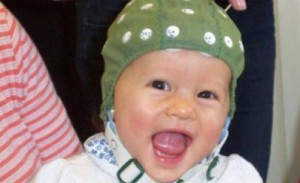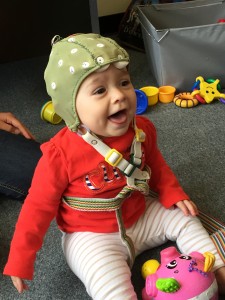 You may have heard us describe the brain wave part of our studies as “ERPs”. What are ERPs, and why are we using them in this research? ERP stands for Event-Related Potentials. ERPs are really the same thing as an EEG that you may have heard of people having in a hospital setting. EEGs are measures of the electrical activity that all of us constantly produce in our brains. We use the same kinds of recording methods and hospitals do for these medical procedures! The special thing about ERP is that we not only measure brain electrical activity, but we measure it in respose to a specific event (that’s where the event-related part comes in!). You may have noticed that the pictures your child saw when participating in our research came and went on the computer monitor very quickly. This is because the faster the picture is presented, the more clear a response we can get and be sure it’s a response to that specific picture. Babies are remarkably good at recognizing pictures even when they’re presented very fast. In fact, in our studies, we show pictures for only ½ a second, and as you will see from reading the following sections, babies are using their brainwaves to tell us many interesting things about what they know and understand.
You may have heard us describe the brain wave part of our studies as “ERPs”. What are ERPs, and why are we using them in this research? ERP stands for Event-Related Potentials. ERPs are really the same thing as an EEG that you may have heard of people having in a hospital setting. EEGs are measures of the electrical activity that all of us constantly produce in our brains. We use the same kinds of recording methods and hospitals do for these medical procedures! The special thing about ERP is that we not only measure brain electrical activity, but we measure it in respose to a specific event (that’s where the event-related part comes in!). You may have noticed that the pictures your child saw when participating in our research came and went on the computer monitor very quickly. This is because the faster the picture is presented, the more clear a response we can get and be sure it’s a response to that specific picture. Babies are remarkably good at recognizing pictures even when they’re presented very fast. In fact, in our studies, we show pictures for only ½ a second, and as you will see from reading the following sections, babies are using their brainwaves to tell us many interesting things about what they know and understand.
You might also have noticed that we show many repetitions of the same pictures during our studies. This is because brain activity is a very messy business, and if you only look at activity in response to a single presentation, it would be very difficult to get much information from it.
We average infants’ brain activity over a large  number of trials. When we do this, we get rid of all of the background “noise” and are left with a picture of what is special about the infant’s brain response to the picture we’ve shown. The picture below shows what we typically see after we do this averaging. The bumps and valleys you see are called ERP components. The components are measured by time (on the bottom, showing the number of milliseconds since the picture was presented) and amplitude (on the vertical axis, showing the voltage of the electrical activity produced). Because of decades of research, much of it here at UCSD, we have some understanding ofwhat these components mean. For example, the Nc component shown in the picture, which occurs about 500 milliseconds (or ½ second) after the baby sees a picture is thought to reflect the infant’s attention to something important or interesting. We compare the timing and size of these peaks between different kinds of pictures (for example, a picture of Mom vs. a picture of a stranger) to see what babies recognize and how they respond to different kinds of pictures.
number of trials. When we do this, we get rid of all of the background “noise” and are left with a picture of what is special about the infant’s brain response to the picture we’ve shown. The picture below shows what we typically see after we do this averaging. The bumps and valleys you see are called ERP components. The components are measured by time (on the bottom, showing the number of milliseconds since the picture was presented) and amplitude (on the vertical axis, showing the voltage of the electrical activity produced). Because of decades of research, much of it here at UCSD, we have some understanding ofwhat these components mean. For example, the Nc component shown in the picture, which occurs about 500 milliseconds (or ½ second) after the baby sees a picture is thought to reflect the infant’s attention to something important or interesting. We compare the timing and size of these peaks between different kinds of pictures (for example, a picture of Mom vs. a picture of a stranger) to see what babies recognize and how they respond to different kinds of pictures.

